Surfer on Big Wave: A Comprehensive Exploration
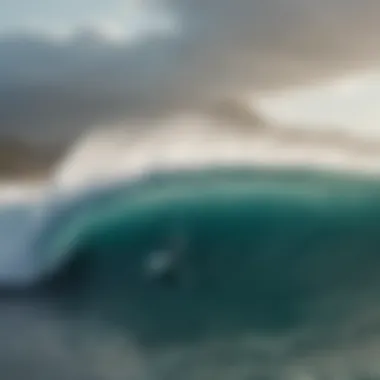
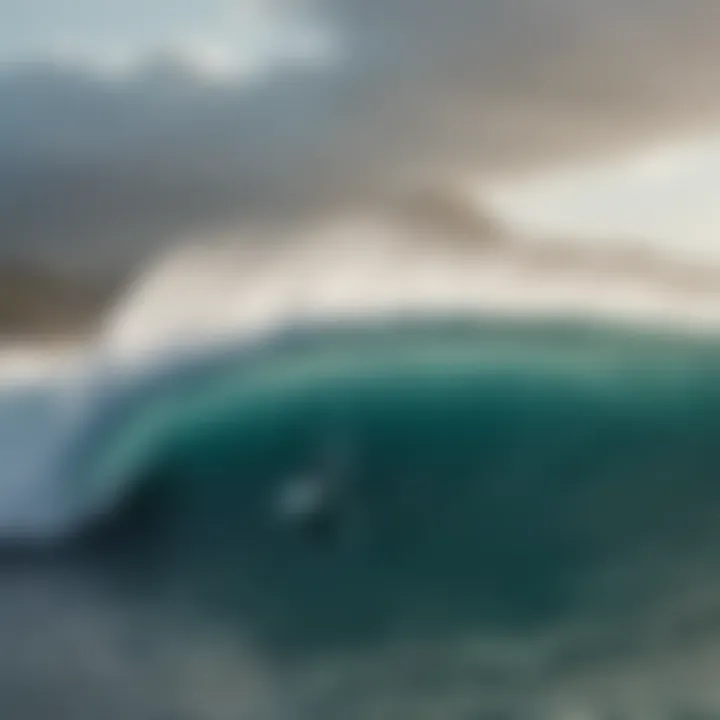
Intro
Big wave surfing is more than just a sport; it’s a test of one’s limits and an intricate dance between man and nature. The thrill of riding these massive swells attracts surfers from all walks of life, but it demands more than just courage. Physical strength, mental fortitude, and a deep understanding of the ocean’s rhythms become paramount for success. This article explores the unfolding synergy between surfers and the colossal waves they encounter, looking not just at the adrenaline rush, but at the preparation, gear, and the heritage that shapes this counterculture.
From Hawaii’s famed North Shore to the relentless swells of Portugal’s Nazaré, surfers have been drawn into the complexity of big wave riding. Each location has its own narrative, full of respect for the ocean and the inherent risks involved. Surfers learn to listen to what the ocean is telling them and respond with both skill and awareness.
In this exploration, we will dive into crucial components of big wave surfing: equipment essentials, techniques, and the cultural significance that binds together this global community. Whether you’re an aspiring big wave rider or a seasoned pro, understanding these layers will enrich your experience in the water.
Prologue to Big Wave Surfing
Big wave surfing is more than just a sport—it's a raw encounter with Mother Nature that pushes the boundaries of human capability. This article will explore the multifaceted world of big wave surfing, highlighting its intricacies, the philosophies behind it, and the techniques involved. For surfers, paddleboarders, and instructors, understanding this realm not only enhances skills but also provides a deeper appreciation for the ocean's might.
Defining Big Waves
Big waves are defined not just by height but also by their power, shape, and the conditions required to produce them. Generally, a wave is considered 'big' when it reaches a height of over 20 feet, and in some notable surf spots, waves can surge well beyond that, reaching heights of 50 feet or more. The perception of what constitutes a big wave can vary widely based on the surfer's background and experience.
Surfers often use visual cues such as the wave’s crest and the force of the water itself to gauge its power. A wave that may look inviting to a novice can pose significant risk to an unprepared rider.
While the measurement may seem straightforward, the nuances add considerable depth to the definition. Waves can be categorized by their breaking patterns—beach breaks, point breaks, and reef breaks—each presenting its own set of challenges. Experience tells surfers when to paddle into a wave and when to hold back, as judgment can make the difference between triumph and disaster.
Historical Context
The roots of big wave surfing can be traced back to ancient Polynesian cultures who harnessed the ocean's power for transportation and recreation. However, modern big wave surfing began to take shape in the early 20th century. Surfing legends like Duke Kahanamoku revived interest and sought to raise the profile of the sport.
During the 1950s and 1960s, the advent of new surfboard technology and changes in surf culture sparked a wave of surfers seeking larger challenges. Notably, a landmark moment occurred in 1969 when the infamous Jaws wave came into focus, showcasing both the beauty and dangers of sizeable surf.
As the decades passed, various surf competitions emerged, pushing the sport into the limelight and attracting spectators worldwide. The introduction of tow-in surfing in the late 1990s expanded the potential for riding bigger waves, allowing surfers to access what once seemed insurmountable. Today, locations like Pipeline and Teahupoʻo are revered for their monstrous swells and have become focal points for both amateurs and professionals alike.
Understanding the historical context of big wave surfing not only informs contemporary practices but also deepens the emotional connection between surfers and the ocean. Each wave carries remnants of past challenges and triumphs, making every ride feel like a tribute to the surfing journey that spans generations.
The Surfer's Perspective
When it comes to big wave surfing, a surfer's mindset can be just as crucial as their physical readiness. The sheer enormity and unpredictability of massive waves demand a level of mental resilience and preparation that cannot be overlooked. The mental state of a surfer shapes their approach to tackling these formidable challenges, defining not only how they respond to the waves themselves but also how they interact with the ocean’s vastness.
Mental Preparedness
Mental preparedness is often the unsung hero in the world of big wave surfing. Surfers must cultivate a strong psychological foundation to face the towering walls of water that come crashing down. This begins with visualization techniques, where surfers picture themselves navigating the wave’s face successfully. By setting a mental blueprint, they can combat fear and anxiety before even hitting the water.
Moreover, staying calm under pressure is key. Surfers know that the ocean doesn’t just reward those who are physically fit but favors those who can keep their cool. An athlete's ability to manage their anxiety can enhance their performance immensely. Some surfers even adopt mindfulness practices, focusing on their breath to ground themselves during intense moments. This concentration helps in making snap decisions necessary for remaining safe and in control.
Key components of mental preparedness include:
- Visualization: Crafting a mental image of success.
- Focus Techniques: Utilizing breathing exercises for clarity.
- Emotional Management: Training oneself to remain calm during chaos.
- Adaptability: Modifying approaches based on conditions.
"The ocean can be both a friend and a foe; understanding its rhythms is vital for survival."
In honing their mental skills, many surfers find strength not only in the act of surfing but in how they approach life’s larger challenges. Setting personal goals, whether it’s mastering a new trick or simply paddling out each day, builds resilience that transcends the waves.
Physical Conditioning
On the flip side, a surfer's physical conditioning is a crucial part of their overall preparation. Big wave surfing undoubtedly requires strength, endurance, and flexibility. While riding an enormous wave looks effortless, it’s the result of countless hours spent honing one's body to withstand the rigors of the sport. Great physical conditioning builds a solid foundation for tackling extreme surf.
Surfers typically engage in a cross-training regimen that encompasses various activities tailored to enhance their surfing abilities. This might include:
- Strength Training: Focusing on core muscles, legs, and upper body to maintain balance and power.
- Cardio Workouts: Such as running or cycling, which help surfers build overall stamina.
- Yoga or Stretching: To increase flexibility and prevent injuries, allowing for better maneuverability on the board.
- Swimming: Essential for improving lung capacity and comfort in turbulent waters, making them better prepared for mishaps.
Physical conditioning isn't just about being fit; it’s about building confidence in one’s body. Surfers who take the time to properly condition themselves face the surge of adrenaline with a sense of control. They know they've trained not only to catch the waves but also to handle the repercussions of wipeouts without fear.
"Your body is your board; care for it like you would a trusted companion on the waves."
Essential Equipment for Big Wave Surfing
When it comes to big wave surfing, the right equipment can make all the difference. It's not just about the thrill of riding massive swells; it's a game of survival and performance. Each piece of gear plays a crucial role in ensuring safety and enhancing the overall experience. Understandably, surfers must consider how they select their gear, from surfboards to safety equipment. This section digs into the essentials that empower surfers to tackle the challenges posed by giant waves.
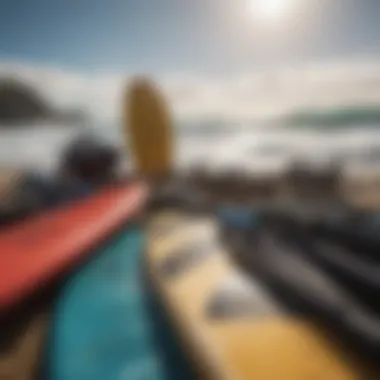
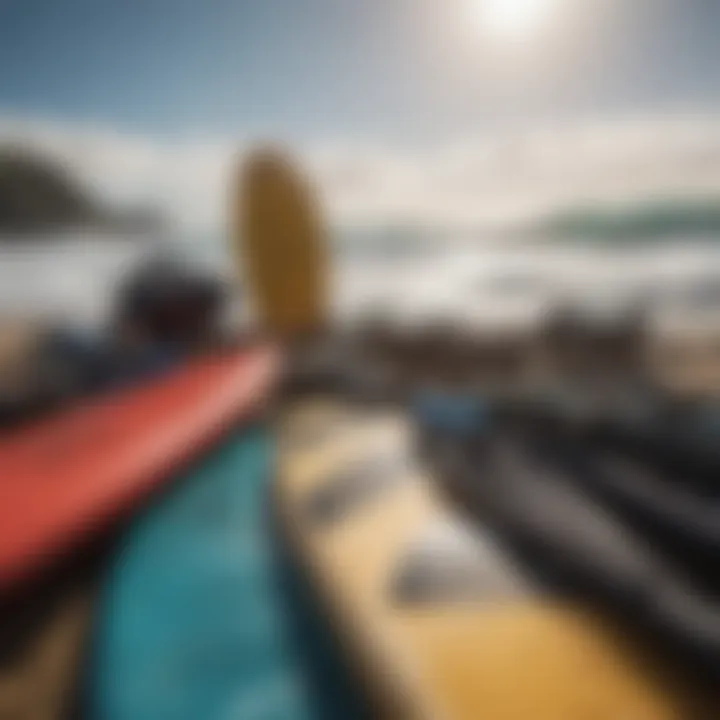
Surfboard Specifications
The surfboard is arguably the centerpiece of big wave surfing. Selecting the appropriate surfboard is a task that demands careful thought, since not all boards are built to handle the rigors associated with enormous swells. Generally speaking, big wave boards are designed to float better and provide more speed. Here are some key specs to consider:
- Length: Often, big wave boards measure anywhere between 9 to 12 feet. A longer board offers stability, which is crucial for navigating big swells.
- Width: Wider boards can provide more buoyancy, essential for paddling into larger waves. It's also beneficial when making tight turns while riding.
- Thickness: A thicker board displaces more water, giving you that extra flotation needed to stay atop larger waves.
- Tail Shape: The tail design impacts performance. Swallow tails can help with maneuverability, whereas a rounded tail might offer better stability.
Surfers like Laird Hamilton have pioneered designs that allow for increased stability and maneuverability while charging into some of the heaviest waves on the planet. These small nuances in specifications can often be the difference between a successful ride and a wipeout.
Wetsuits and Safety Gear
A well-fitted wetsuit is more than just a style choice—it's a matter of comfort and safety in the freezing waters that often accompany big wave surfing. Surfers face the risk of hypothermia if they're in the water for extended periods, so here’s what to keep in mind:
- Thickness: Wetsuits come in different thicknesses, typically ranging from 4/3mm to 6/4mm for extremely cold water. This rating indicates the millimeters of neoprene used, with the first number referring to the thickness of the torso and the second to the limbs.
- Seams: Look for sealed seams which promise better insulation and water resistance—essential for those frigid big wave sessions.
- Buoyancy Vests: While not a wetsuit, these vests work wonders in terms of added buoyancy during wipeouts, allowing surfers to return to the surface quickly.
Always ensure to consider your local conditions and personal preferences when selecting your wetsuit and any safety gear. The right outfit not only provides warmth but can dramatically reduce the risks associated with big waves.
Safety Considerations
Surviving a big wave session isn't just about having the right gear; it involves understanding the potential dangers and preparing for them. Here are some critical safety considerations:
- Local Knowledge: Each surf spot has its quirks—understanding currents, tides, and local wildlife is crucial.
- Buddy System: Always surf with a partner. Not just for fun but for safety. This ensures someone’s watching your back.
- Leashes: A strong leash is necessary. Losing your board in the midst of a powerful wave can pose serious dangers both to you and other surfers.
- Emergency Protocols: Know what to do in emergencies—this can be as straightforward as knowing how to signal for help or having a designated location for rescue equipment.
"Safety first, always. The ocean is unpredictable, and preparation is key."
Techniques for Mastering Big Waves
Mastering the art of riding giant swells entails more than just courage or skill. It requires a keen understanding of several tactical aspects that can mean the difference between blissful ride and disaster. Whether you're a budding surfer or an experienced hand eager to refine your abilities, mastering these techniques is vital for your safety and success in big wave surfing.
Paddling Strategies
Paddling might sound basic, but when you're staring down a wall of water towering above you, the right technique is invaluable. Good paddling methods can help you efficiently navigate through choppy water and position yourself optimally for take-off.
One key strategy is to maintain a steady rhythm, similar to a clock's tick-tock. This keeps your momentum flowing, enabling you to gain speed quickly. Keeping your body low can also serve better aerodynamics and reduce drag. Here are some tips:
- Engage Your Core: A strong core will stabilize your body, making it easier to paddle effectively through turbulence.
- Utilize Arm Techniques: Use long, deep strokes with your arms to maintain control and speed rather than short, frantic paddles.
- Look Ahead: Always keep an eye on approaching waves, as this will help you gauge when to paddle harder or adjust your positioning.
Mastering these paddling strategies will not only boost your ability to catch waves but also improve your stamina for longer rides.
Timing and Positioning
Timing and positioning are critical elements in big wave success. Without proper timing, you might miss your opportunity or face the chaos of getting stuck in a wipeout. The goal is to strike at just the right moment — not too early, not too late.
The positioning strategy can be summarized in these guidelines:
- Observe the Swell Patterns: Understanding how waves break at your chosen spot can give you a strategic edge. Recognizing a "set" can illuminate when to paddle and where to position yourself for optimal take-off.
- Choose Your Spot Wisely: Distance from the take-off point matters. Too far, and you won’t catch the wave; too close, and you risk getting hammered by it. The sweet spot lies in knowing where you’ll be in relation to the wave when it reaches its peak.
- Shift Your Weight: When you spot a wave that’s ready to break, subtly shift your weight forward on the board. This helps with both speed and balance as you prepare to drop down the face of the wave.
Acquiring a sense of timing and precise positioning equips you to effectively respond to incoming swells, thereby enhancing your success and enjoyment.
Riding the Wave: Mechanics and Dynamics
Riding big waves is the culmination of skill, heart, and a little bit of science. Understanding the mechanics and dynamics can be the difference between a triumphant ride and a disheartening plunge. The moment you drop in, gravity takes hold, and that’s where strategy becomes crucial.
The following aspects are key to mastering the ride:
- Balance is Key: Leaning too far forward can put you at risk of nosediving, while leaning back can lead to losing speed. A centered stance keeps you balanced as you maneuver down the wave face.
- Reading the Wave: Each wave carries its own rhythm. Learning to read how a wave is forming and breaking helps you make swift adjustments while riding, whether it’s turning, charting a new course, or performing a trick.
- Use of Edges: Engaging your board’s rails (or edges) allows you to carve through the wave, maintain speed, and control direction. This allows for maneuvers that make the ride not just successful but also aesthetically pleasing.
"Understanding the science of wave dynamics opens vistas of possibilities while riding and turns every session into a thrilling learning experience."
By grasping these complex techniques, surfers can transform the seemingly impossible into exhilarating achievements. The mastery of big waves could very well be a fusion of art and athletic endeavor, grounded in strategy and keen observation.
Iconic Big Wave Locations
The allure of big wave surfing is not just about conquering towering walls of water; it’s deeply tied to specific geographic locales. These regions become meccas for surfers who wish to challenge themselves against nature's mightiest creations. Beyond the thrill, each spot has its own personality, history, and cultural significance that add layers of meaning to the sport. Whether you’re a seasoned pro or a curious onlooker, understanding these locations elevates your appreciation for the sport.
Pipeline, Hawaii
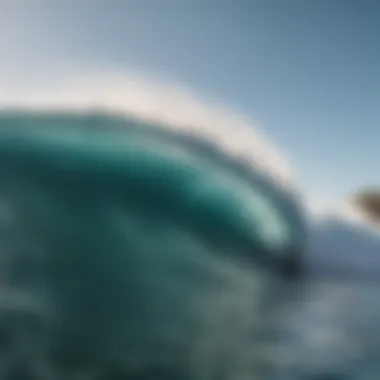
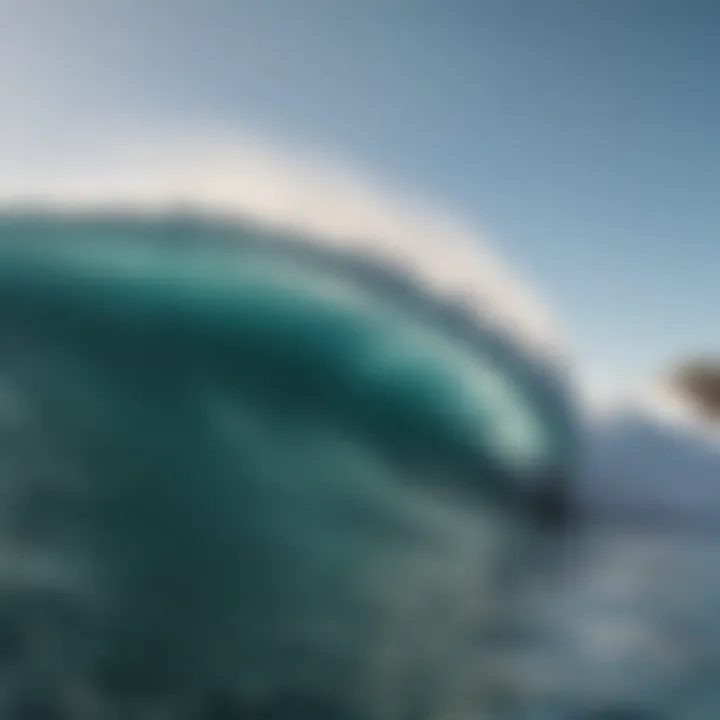
Pipeline, located on Oahu's North Shore, is often regarded as the crown jewel of big wave surfing. Known for its flawless, barreling waves, this spot poses a unique mix of beauty and danger. The wave breaks over a shallow reef, causing it to hollow out perfectly, often allowing surfers to ride inside the tube. However, this beauty comes with significant risks; surfers must be acutely aware of the ocean’s whims, as unrelenting waves can lead to injuries.
The local surfing culture here is rich and steeped in history. It’s where some of the most legendary figures in surfing have built their legacies. Locals emphasize a deep respect for the ocean, and there’s an unspoken code among surfers. Learning to navigate the line-up requires not just skill but also insight into the social dynamics at play. Riding at Pipeline is not just about catching a wave; it’s about earning your place in a storied tradition.
Teahupoʻo, Tahiti
Venture a bit further into the South Pacific, and you’ll reach Teahupoʻo, acclaimed for producing some of the heaviest waves on the planet. The name itself evokes awe, translating to "thick reef" in Tahitian. Its waves can tower dramatically, heavy with water and almost closing out on themselves. The ride here demands an unmatched level of courage and skill; many surfers describe endeavors at Teahupoʻo as humbling, token to the ocean’s sheer power.
The wave’s unique formation results from how it breaks over the shallow reef bottom. This invites gigantic swells turning into punishing walls, resulting in breathtaking but dangerous conditions. More than just a surfing location, Teahupoʻo represents a unique blend of Tahitian culture and strong community, where local surfers play a pivotal role. Their expertise is not simply about riding waves but embracing tradition while adapting modern tactics for safety and success.
Mavericks, California
Traveling north to California, Mavericks stands as another iconic big wave destination. Located just outside of San Francisco, it combines stunning coastal scenery with some of the biggest swells in the world. Historically, Mavericks did not enjoy the same spotlight as Pipeline or Teahupoʻo until a passionate surf community began to foster its reputation through contests and events.
The waves here are generated by deep ocean conditions further offshore, allowing them to build to massive heights before breaking violently against the rocky coastline. This area shapes a particular breed of surfer, one who thrives in unpredictability and wild conditions. Beyond the surfing, Mavericks hosts a unique camaraderie among locals and visitors alike, turning it into more than just a surfing venue but a gathering point for stories of triumph and adversity among surfers.
"Each wave at Mavericks has its own character. You can never be prepared for exactly what you’ll face each time you paddle out."
In summary, the iconic locations of Pipeline, Teahupoʻo, and Mavericks serve as essential touchpoints in the world of big wave surfing. They offer surfers challenges that push their limits while weaving a fabric of culture, community, and respect for the ocean. Understanding these locations not only enhances the surfing experience but also connects the sport to its rich history and community ethos.
Big Wave Surfing Contests and Events
Big wave surfing contests and events are more than just competitions; they embody the spirit of adrenaline, camaraderie, and raw connection with nature. In the world of surfing, these events serve as a stage where the limits of human capability are pushed against the might of the ocean, creating a theatrical experience that is both thrilling and dangerous. Beyond the excitement of the contests, they also play a pivotal role in fostering community, encouraging local economies, and showcasing the immense talent of surfers.
The Big Wave World Tour
The Big Wave World Tour (BWCT) holds a distinguished place in the realm of big wave surfing. Established to recognize the bravest surfers capable of riding the most formidable waves across the globe, it brings together the best of the best. Each season, surfers place their lives on the line, vying for glory at iconic locations like Jaws in Maui, or the treacherous waves at Nazaré in Portugal.
Importance of the Tour:
- Global Recognition: The BWCT has become the pinnacle of achievement for surfers, a title that opens many doors in the industry and solidifies a rider's reputation.
- Innovative Surfing Techniques: The competition acts as a crucible for new techniques as surfers adapt to the chaos of massive swells. The ingenuity displayed here can often redefine surfing.
- Inspiration for New Generations: With live broadcasts, younger surfers see firsthand what is possible, pushing them to train harder and dare more.
Each contest is meticulously planned around the ever-unpredictable nature of ocean swells. When the forecast looks promising, surfers gather with their communities, all holding their breath for a chance to witness rides that can last seconds yet last in memory forever.
Local Competitions and Community Events
While the BWCT shines on a global level, local competitions play an equally crucial role, acting as a grassroots movement in the big wave surfing community. These events, often hosted at regional hotspots, offer surfers a chance to test their skills in a more familiar environment.
Benefits of Local Competitions:
- Fostering Community Spirit: Local contests build relationships among surfers, their families, and onlookers. They create an atmosphere of support and enthusiasm that larger events sometimes can’t replicate.
- Nurturing Local Talent: New and upcoming surfers gain invaluable experience and exposure, often leading to future opportunities in bigger competitions.
- Economic Booster: These events attract visitors, benefiting local businesses such as restaurants, hotels, and surf shops, uplifting the community.
"Surfing is not just a sport; it's a lifeblood in many coastal communities."
— Anonymous Surfer
In summary, both global events like the Big Wave World Tour and local competitions are vital to the culture of big wave surfing. They not only highlight incredible feats by surfers but also represent the collective growth and rich tapestry of the surfing community. The challenges faced in these competitions, along with the triumphs, create stories that linger far beyond the waves—a true testament to the spirit of surfing itself.
Cultural Impact of Big Wave Surfing
Big wave surfing is not just a sport; it shapes identities, communities, and artistic expressions around the globe. Its cultural impact resonates far beyond the surf breaks and sandy beaches. From documentaries showcasing the heart-stopping thrill of riding gargantuan waves to art that encapsulates the serenity and chaos of the ocean, big wave surfing intertwines itself into the fabric of society. This connection is evident in the way it influences lifestyles, values, and even aspirations of surfers and non-surfers alike.
The allure of conquering nature’s immense power has birthed not only a subculture driven by adrenaline but also a profound respect for the ocean's strength. This relationship between surfer and sea informs social dynamics, frequently fostering a sense of community among enthusiasts. Such gatherings—be it competitions, exhibitions, or informal meets—serve to strengthen bonds and inspire collective narratives that celebrate courage and respect for the unpredictable forces of nature.
Influence on Art and Media
Art and media have become potent avenues through which the essence of big wave surfing is captured. Visual artists often depict the awe-inspiring beauty and relentless might of the ocean, portraying both the majesty and danger that define the sport. Paintings, photography, and even performance art have drawn heavily on the dramatic imagery and emotional undercurrents associated with these colossal waves.
In the realm of media, documentaries like "Riding Giants" have put a spotlight on legendary surfers and their challenges, echoing themes of risk, triumph, and the pursuit of excellence. These narratives go beyond mere entertainment; they act as cultural texts that inform the public's perception of surfing. By celebrating the surfers' journeys, media helps cultivate a deeper understanding of the personal sacrifices and triumphs involved in pursuing the wave ride of a lifetime.
Moreover, social media platforms have amplified voices within the surfing community, allowing individuals to share their experiences and connect with like-minded souls across the globe. The power of platforms such as Instagram or TikTok aids in spreading the sport's culture, showcasing both the highs and lows of a surfer’s journey, effectively creating a digital tapestry of aspirations and achievements.
Surfing as a Lifestyle
Surfing transcends being just a hobby or sport; it often manifests as a lifestyle choice. For many, the pursuit of big waves becomes intertwined with daily living, reflecting in dietary choices, travel habits, and personal philosophies. The commitment to physically preparing for the ocean's challenges is a cornerstone for those who embrace this lifestyle.
Beyond the physical aspects, following the big wave season around the world transforms into a ritual. This pilgrimage to locations such as Hawaii, Tahiti, and California doesn't just revolve around catching waves but also involves a deeper connection to a global community. The tribes formed among surfers—bound by shared experiences and values—underscore the importance of camaraderie, respect, and environmental stewardship.
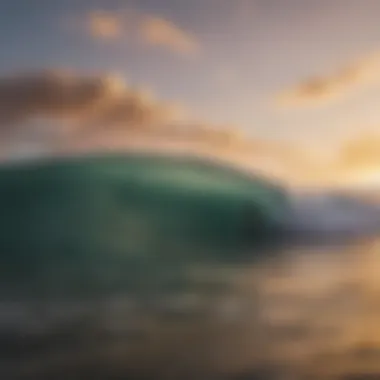
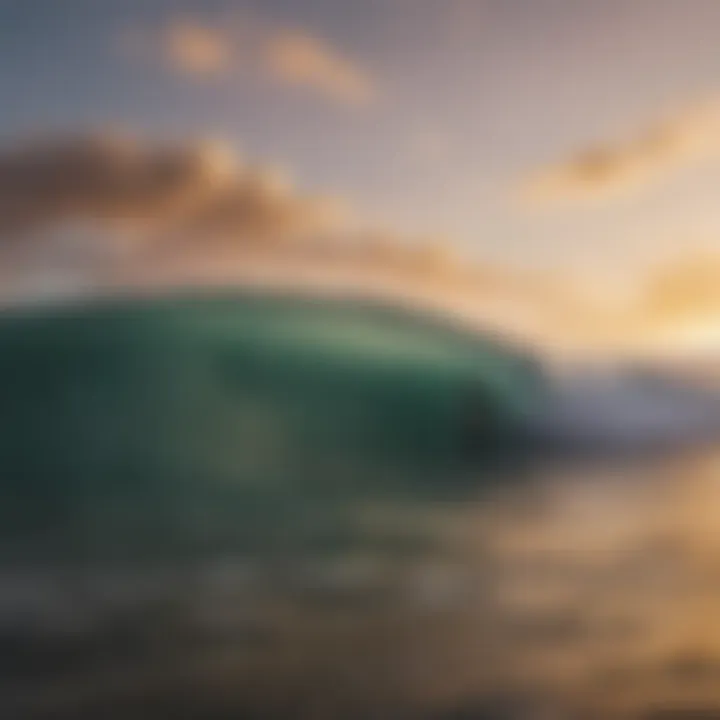
Surf culture often emphasizes sustainability and awareness of environmental issues that affect ocean life. Advocating for responsible practices, many surfers actively participate in initiatives aimed at conserving marine ecosystems, establishing a sense of responsibility towards nature that is deeply ingrained within the community.
Through these various dimensions—artistic expressions, media portrayals, and lifestyle choices—the cultural impact of big wave surfing emerges as a rich, multifaceted narrative. It encourages respect for nature, fosters community ties, and inspires individuals to pursue their passions wholeheartedly. As surfers continue to ride these monumental waves, they carry with them stories that ripple through society, echoing the sport's profound influence on modern culture.
The Future of Big Wave Surfing
The future of big wave surfing presents a fascinating intersection of technology, environmental stewardship, and evolving cultural values. As surfers continue to push the limits of what is possible, new innovations are reshaping how they approach the massive swells. One can hardly overstate the importance of this topic—not only does it delve into the technical advancements that empower surfers, but it also addresses the pressing need for sustainable practices in a world where active engagement with nature can have profound consequences.
Innovations in Technology
In recent years, various technological advancements have significantly transformed big wave surfing, enhancing both performance and safety. Surfers today are better equipped than ever with gear developed through high-level research and investment. Innovations like the following are changing the game:
- Advanced Surfboard Designs: Modern surfboards now come equipped with materials that are both lighter and stronger, allowing for enhanced maneuverability in the water. Fiberglass and epoxy blends, for instance, have revolutionized board construction, making them more resilient against the immense forces of big waves.
- Jet Surfboards: Jet surfboards seamlessly combine traditional surfing with throttle-controlled propulsion. This allows surfers to reach bigger waves faster and break through obstacles with ease.
- Wearable Tech and Sensors: Many surfers now use gadgets that track heart rate, wave heights, and even impact alerts. These wearables can alert a surfer (or their support team) about crucial data that facilitates split-second decisions during rides, possibly saving lives when conditions worsen unexpectedly.
"As technology evolves, so do the capabilities of the surfer, ensuring a safer, more exhilarating ride, while respecting the power of the ocean."
With these innovative technologies, the landscape of big wave surfing is altering rapidly. However, the thrill of surfing also begs for consideration of the environment.
Environmental Considerations
While advancements inject new excitement into big wave surfing, one cannot overlook the pressing environmental issues tied to it. As surfers, we are custodians of the ocean, facing significant challenges ahead:
- Climate Change Effects: Shifting ocean temperatures and rising sea levels present real threats to surf conditions and the ecosystems surfers depend on. It's essential for the community to acknowledge these changes to understand the effectiveness of various surf spots in the long run.
- Sustainable Practices: Initiatives such as using eco-friendly materials for surfboards and gear can make a significant impact. Some companies are now focusing on creating biodegradable surfboard components and minimizing harmful adhesives that contribute to pollution.
- Protecting Marine Life: As big wave surfers, respecting the ocean goes beyond catching the perfect wave. Awareness of local wildlife and its habitats should be an integral part of the surfing culture. Avoiding areas that damage reefs or habitats is crucial for the ocean's future.
To harness the future effectively, surf brands and the community must collaborate to create courses of action that prioritize sustainability. New educational programs targeted at surfers and enthusiasts can forge paths towards more responsible surfing practices.
Personal Stories from Big Wave Surfers
Personal stories from big wave surfers provide a unique window into the dynamic and often unpredictable world of surf culture. These narratives capture not just the astonishing feats achieved on towering waves, but also the personal growth, profound challenges, and intimate moments faced by surfers navigating their paths. They add layers of depth to the sport, illustrating how the ocean's raw power both humbles and empowers those who dare to face it.
The importance of these stories lies in their ability to connect the surfing community and offer insights into the mindset, resilience, and commitment required for big wave surfng. Such narratives resonate even with those who may never paddle out themselves, evoking the intricate relationship between humans and nature. Furthermore, they are essential for teaching younger generations about respect and safety in the ocean, as they learn from the hard-won experiences of their predecessors.
Triumphs and Challenges
The triumphs and challenges faced by big wave surfers are as exhilarating as the waves they conquer. From the high of riding a gigantic swell to the lows of wipeouts and injuries, each surfer develops a personal story filled with peaks and valleys.
Take, for instance, the incredible tale of Laird Hamilton, who is often revered as one of the pioneers of big wave surfing. Laird's journey includes some monumental moments, such as his first ride at Jaws in Maui, where waves often reach over 60 feet. The feeling of seamlessly gliding down a monstrous wall of water brings a rush like no other, marking a peak in Laird’s career as he truly embraced the ocean's force. Yet, this high comes with risks; Laird has faced countless injuries, testing his physical limits and mental fortitude. These dualities in his journey reflect the essence of big wave surfing — breathtaking successes interwoven with tough challenges.
In contrast, many surfers recount tales of significant wipeouts, where they found themselves trapped under the water in violent chaos. Such near-death experiences serve not only as cautionary tales but also as lessons in humility and resilience. These stories often touch upon how surfers learn to manage fear, embrace vulnerability, and safely navigate both the waves and their own minds.
Lessons Learned
The lessons learned through these experiences frequently echo through the surf community. Surfers emphasize the importance of preparation and mental strength when facing the ocean’s might. Many recount the value of being physically fit but highlight that mental readiness is often the unsung hero. Surfers learn that a calm mind can mean the difference between riding a wave or being overtaken by it. Instead of succumbing to fear, they cultivate techniques that allow them to focus amidst chaos, which is transferable to all areas of life.
Additionally, big wave surfing fosters a deep respect for the ocean. Many surfers start with a naive enthusiasm, only to be taught by the ocean herself about the balance of power and grace. They learn that nature's might should never be taken lightly, and each wave carries its own personality. This respect becomes the bedrock of their passion, shaping both their approach to surfing and their lifestyle choices.
In summary, personal stories from big wave surfers reflect a rich tapestry of experiences that bind the surfing community together. They illuminate the exhilarating highs, the crushing lows, and the wealth of wisdom gleaned from encounters with nature's might. Through these tales, not only do surfers find catharsis, but they also inspire others to paddle out, embrace the waves, and respect the ocean that weaves through us all.
"You cannot stop the waves, but you can learn to surf." - Jon Kabat-Zinn
These narratives remind us that every surfer’s journey is unique, yet interconnected. As they navigate the endless surf, they also navigate life, carving out stories that resonate within and beyond the ocean.
Finale: The Essence of the Big Wave Experience
In bringing together the multifaceted narrative of big wave surfing, the conclusion serves as a critical pivot point to encapsulate the diverse experiences, emotions, and philosophies that surge through this thrilling sport. Understanding the essence of the big wave experience is not merely about the physical act of riding monumental swells; it is equally about interpersonal connections, moments of introspection, and the lessons learned through the dance with nature's most formidable forces.
Reflecting on the Journey
As we regard the journey from the first hesitant paddles to conquering massive walls of water, it becomes clear how this path is filled with both triumphs and tribulations. Each ride shapes not only the individual surfer but also serves to deepen the affinity for the ocean. Surfers often express that getting wiped out is part and parcel of their growth. It’s a reality check that nudges one back to training, urging for a return that’s marked by intensity and purpose.
- Personal Growth: For many, big wave surfing accelerates personal development. It teaches humility, respect for nature, and the importance of building resilience. Every fall and rise becomes a lesson carved in water.
- Community Bonds: The experiences shared between surfers form an unspoken bond. Whether they celebrate a successful ride or console each other after a wipeout, this unity underscores the essence of community that thrives on the waves.
"The ocean is a teacher, and every wave is a lesson in patience and perseverance."
- Uniting these elements becomes essential in fostering an atmosphere of safety and camaraderie on the shores and beyond.
Looking Ahead
As we cast our eyes toward the future of big wave surfing, a kaleidoscope of possibilities emerges. Innovations in technology promise to enhance safety and performance. Wearable devices and advanced surfboard designs can lead to a new era where surfers not only ride waves but do so with increased data-driven insights.
- Safety Advancements: With the introduction of smart wetsuits equipped with tracking devices, surfers can now venture into the waters with added layers of safety.
- Environmental Sustainability: The dialogue around environmental considerations is growing louder. Surfers are beginning to advocate for ocean conservation, realizing that their playground is also at risk. This shift in mentality could reshape the sport into a more environmentally conscious endeavor.



